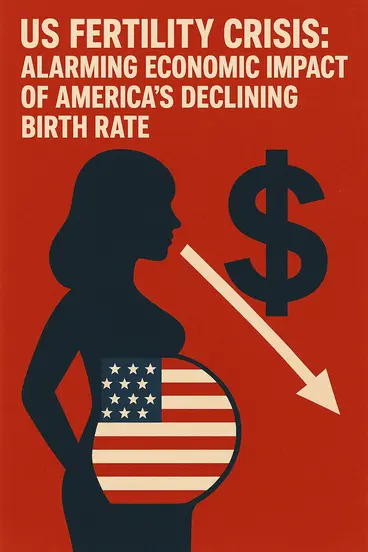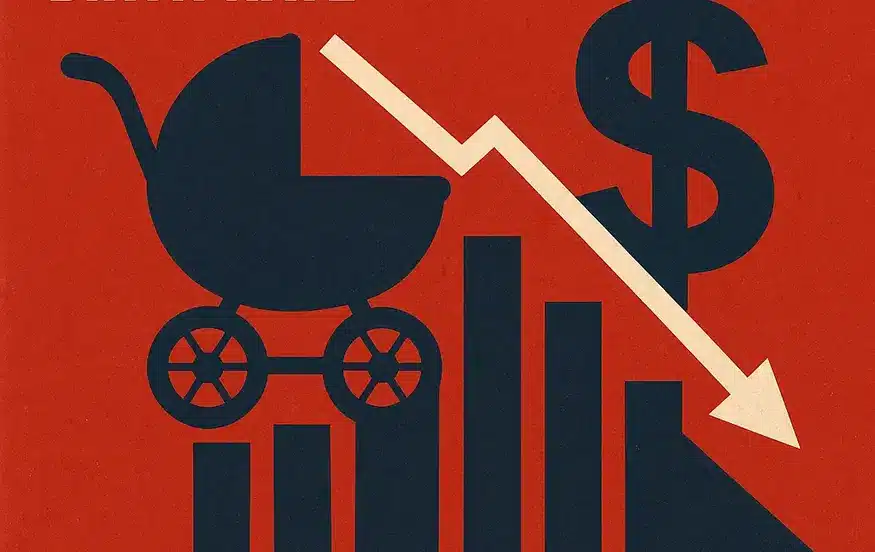The Troubling Numbers Behind America’s US Fertility Crisis
America birth rate is at a historic low, signaling a significant US fertility crisis. Currently, the birth rate hovers around 1.6 births per woman, well below the 2.1 replacement level needed to sustain the population. Experts project that nearly 25% of today’s young adults in America will never have children, creating demographic shifts that will profoundly affect the economy for decades.
This decline in america birth rate is more than just a social issue it poses a major economic challenge. As the ratio of working-age adults to retirees shrinks, programs like Social Security and Medicare face increasing financial pressure, potentially impacting economic stability and growth.
The Looming Economic Consequences
The US fertility crisis creates several economic pressures:
- Reduced consumer spending and economic growth
- Fewer workers to support aging populations
- Increased pressure on government programs
- Potential labor shortages in critical sectors
- Reduced innovation and entrepreneurship
According to Social Security trustees, the program is only expected to remain solvent until 2033, creating urgency around demographic solutions. While some suggest higher birth rates could help, this approach wouldn’t address immediate solvency concerns, as new babies wouldn’t enter the workforce for at least two decades.
Political Responses to the US Fertility Crisis
Both major political parties recognize the US fertility crisis as a challenge requiring policy intervention, though their approaches differ significantly. Republicans have proposed a $5,000 “baby bonus” paid at birth, while Democrats have advocated for an expanded child tax credit system providing ongoing support.
The debate often splits along ideological lines, with figures like Elon Musk and JD Vance promoting traditional family structures and encouraging “the best and brightest” to have more children. Meanwhile, progressives tend to focus on creating structural supports that make combining work and family more feasible.

Why One-Time Financial Incentives Fall Short
Experts suggest that one-time payments or modest tax benefits are unlikely to significantly impact fertility decisions. The estimated 18-year cost of raising a child in America exceeds $300,000 for middle-income families according to USDA calculations, making a $5,000 bonus relatively insignificant in the broader financial equation.
Research indicates that substantially increasing the child tax credit to around $4,500 (from the current $2,000) might boost fertility rates by 3-10%. While modest in the short term, such policies could result in millions of additional births over decades if consistently maintained.
Beyond Money: Structural Barriers in the US Fertility Crisis
The United States remains an outlier among developed nations in lacking key policies that support families, including:
- No federal paid parental leave
- Limited affordable childcare options
- Inflexible work arrangements
- Expensive housing in job-rich areas
- Limited fertility treatment coverage
Even countries with robust family support systems continue to struggle with fertility rates, though some like France have managed to maintain higher rates than their European neighbors. This suggests that while policy matters, deeper cultural and economic factors are also at play in the US fertility crisis.
Hiring in Healthcare or Elder Care?
Senior care and Healthcare jobs on WhatJobs to help address our aging population challenges
The Cultural Shift in Family Formation
Modern Americans face complex trade-offs when considering parenthood:
- Later marriage and partnership formation
- Extended education and career establishment periods
- Housing affordability challenges
- Intensive parenting expectations
- Unequal domestic labor distribution between partners
Many young adults prioritize education, career advancement, and financial security before considering parenthood, pushing family formation into later years when fertility naturally declines. Women, in particular, face difficult choices between career advancement and family formation during prime reproductive years.
Looking for family-friendly career options? Search thousands of flexible jobs on WhatJobs that offer better work-life balance.
Looking for expert career planning advice?
Get practical tips to balance your passion and goals for a successful career.
Potential Solutions to America’s US Fertility Crisis
Addressing the US fertility crisis likely requires a comprehensive approach beyond simple financial incentives:
- Workplace flexibility: Normalized part-time and flexible work options for parents
- Childcare infrastructure: Universal pre-K and affordable daycare options
- Housing policy: Family-friendly housing development in job-rich areas
- Healthcare improvements: Expanded fertility treatment coverage
- Immigration: Strategic immigration policies to address immediate workforce needs
While immigration can help offset some economic impacts of population decline, it’s not a permanent solution, as fertility rates are falling globally. Mexico and many other traditional sources of US immigrants now have below-replacement fertility themselves.
Any effective approach to the US fertility crisis will require sustained, long-term investments rather than quick fixes. Cultural norms around parenting, work, and family formation have evolved significantly, and policy must adapt to these new realities.
FAQs About the US Fertility Crisis
What is causing the US fertility crisis?
The US fertility crisis stems from multiple factors including economic uncertainty, housing costs, student debt, delayed marriage, intensive parenting expectations, and cultural shifts prioritizing education and career before family formation. Unlike temporary fertility declines during recessions, this appears to be a persistent trend that didn’t rebound after the Great Recession.
How does the US fertility crisis affect Social Security?
The US fertility crisis directly impacts Social Security by reducing the ratio of workers to retirees. With fewer young workers paying into the system while more baby boomers retire and draw benefits, the program faces significant financial pressure. The Social Security trustees currently project the program will remain solvent only until 2033 without substantive changes.
Can government policies effectively address the US fertility crisis?
Evidence suggests government policies can modestly influence the US fertility crisis, but dramatic changes are unlikely. Substantial, sustained investments in family support like significantly expanded child tax credits, affordable childcare, and paid leave might increase fertility rates by 3-10%, which could make a meaningful difference over decades but won’t solve immediate demographic challenges.
How does the US fertility crisis compare to other countries?
The US fertility crisis mirrors trends in other developed nations, though America’s rate of 1.6 births per woman remains higher than many East Asian and Southern European countries. Japan, Italy, South Korea, and Spain have experienced more severe population declines and associated economic challenges, potentially offering lessons for American policymakers about the long-term consequences of sustained low fertility.




